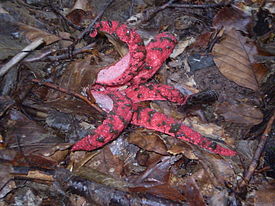- Clathrus archeri
-
Octopus Stinkhorn 
Octopus Stinkhorn (Clathrus archeri) with suberumpent eggs Conservation status uncommonScientific classification Kingdom: Fungi Division: Basidiomycota Class: Agaricomycetes Order: Phallales Family: Phallaceae Genus: Clathrus Species: C. archeri Binomial name Clathrus archeri
(Berk.) Dring 1980Clathrus archeri Mycological characteristics 
glebal hymenium 
no distinct cap 
hymenium attachment is irregular or not applicable 
lacks a stipe 
spore print is olive-brown 
ecology is saprotrophic 
edibility: inedible Clathrus archeri (synonyms Lysurus archeri, Anthurus archeri, Pseudocolus archeri), commonly known as Octopus Stinkhorn, is indigenous to Australia and Tasmania and an introduced species in Europe and North America. The young fungus erupts from a suberumpent egg by forming into four to seven elongated slender arms initially erect and attached at the top. The arms then unfold to reveal a pinkish-red interior covered with a dark-olive spore-containing gleba. In maturity it smells of putrid flesh.
Contents
Habitat
It is found gregarious to clustered in moist, shaded meadows and deciduous or mixed forests during July to September.
Dissemination
The pinkish-red color and fetid odour of the ripe fungus is thought to resemble decaying flesh and thereby attracting flies which unwittingly spread the gleba and thus the species.
Edibility
The Octopus Stinkhorn is edible, but its taste is extremely foul. The eggs of this fungus taste and smell like radish and are the only edible stage. It should only be eaten in a wilderness survival circumstance when no other food is available. In other cases, it is considered inedible.
 An Octopus Stinkhorn spotted in Kalmthout
An Octopus Stinkhorn spotted in Kalmthout An Octopus Stinkhorn spotted in Şuncuiuş
An Octopus Stinkhorn spotted in Şuncuiuş
References
- Arora, D & WR Burk (1982) Clathrus archeri, a Stinkhorn New to North America, Mycologia 74. pp. 501-504.
- Calonge, Francisco D. (1998) Gasteromycetes, I. Lycoperdales, Nidulariales, Phallales, Sclerodermatales, Tulostomatale in Flora Mycologica Iberica, Vol 3, J Cramer, Berlin, Germany. p. 271.
- Dring, DM (1980) Contributions towards a rational arrangement of the Clathraceae, Royal Botanic Gardens, Kew, Surrey, England. p. 96.
- Pegler, DN et al. (1995) British Puffballs, Earthstars, and Stinkhorns, Royal Botanic Gardens, Kew, England. p. 255.
The Great Encyclopedia of Mushrooms. By Jean-Louis Lamaison and Jean- Marie Polese Page 191
Categories:- Phallales
- Fungi native to Australia
- Fungi of Europe
- Fungi of North America
Wikimedia Foundation. 2010.

